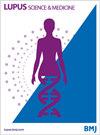系统性红斑狼疮患者的认知能力测量比较
IF 3.7
2区 医学
Q1 RHEUMATOLOGY
引用次数: 0
摘要
客观认知障碍是系统性红斑狼疮患者的常见症状,但客观测量认知能力的方法各不相同。我们利用在基于人群的系统性红斑狼疮患者队列中收集到的数据,比较了多种认知测量指标的表现和潜在损伤。方法 在单次研究访问期间(2019 年 10 月至 2022 年 5 月),记录完成路径制作测试 B(TMTB;N=423)的时间;潜在损伤定义为经年龄校正和教育校正后的 T 分数比常模时间长 1.5 SD)。此外,还进行了时钟绘制评估(CLOX;N=435),包括两个部分(自由绘制时钟(CLOX1)和复制时钟(CLOX2))(评分范围:0-15;分数越高=表现越好);潜在障碍定义为 CLOX1 比常模分数低 1.5 SD)。结果 参与者(平均年龄 46 岁;92% 为女性;82% 为黑人)的 TMTB 时间中位数(IQR)为 96(76-130)秒;CLOX1 和 CLOX2 的得分中位数(IQR)分别为 12(10-13)分和 14(13-15)分;流体认知标准分数的平均值(SD)为 87.2(15.6)分。TMTB 时间和流体认知得分(ρ=-0.53,p<0.001)是相互关联度最高的测量指标。总体而言,在 TMTB 测试、CLOX 任务和 NIH 工具箱流体认知测试中,分别有 65%、55% 和 28% 的人存在潜在障碍。虽然 TMTB 和 CLOX 之间的潜在障碍存在重叠,但超过半数(58%)的人只在其中一项评估中存在障碍。只有极少数人(2%)仅在流体认知方面存在障碍。结论 TMTB、CLOX 和 NIH 流体认知电池都提供了有关系统性红斑狼疮队列认知表现的独特且潜在的重要信息。未来的研究需要验证这些测量方法在系统性红斑狼疮中的有效性,并探索在这一人群中保持或改善认知能力的干预措施。如有合理要求,可提供相关数据。根据美国国立卫生研究院(NIH)的要求,在资助完成后将提供去身份化的数据。本文章由计算机程序翻译,如有差异,请以英文原文为准。
Comparison of cognitive performance measures in individuals with systemic lupus erythematosus
Objective Cognitive impairment is a common complaint in SLE, but approaches to measuring cognitive performance objectively vary. Leveraging data collected in a population-based cohort of individuals with validated SLE, we compared performance and potential impairment across multiple measures of cognition. Methods During a single study visit (October 2019–May 2022), times to complete the Trail Making Test B (TMTB; N=423) were recorded; potential impairment was defined as an age-corrected and education-corrected T-score <35 (>1.5 SD longer than the normative time). A clock drawing assessment (CLOX; N=435) with two parts (free clock draw (CLOX1) and copy (CLOX2)) was also performed (score range: 0–15; higher scores=better performance); potential impairment was defined as CLOX1 <10 or CLOX2 <12. Fluid cognition (N=199; in-person visits only) was measured via the National Institutes of Health (NIH) Toolbox Fluid Cognition Battery and expressed as age-corrected standard scores; potential impairment was defined by a score <77.5 (>1.5 SD lower the normative score). Results Participants (mean age 46 years; 92% female; 82% black) had a median (IQR) TMTB time of 96 (76–130) s; median (IQR) CLOX1 and CLOX2 scores of 12 (10–13) and 14 (13–15); and a mean (SD) fluid cognition standard score of 87.2 (15.6). TMTB time and fluid cognition score (ρ=−0.53, p<0.001) were the most highly intercorrelated measures. Overall, 65%, 55% and 28% were potentially impaired by the TMTB test, CLOX task and NIH Toolbox Fluid Cognition Battery, respectively. While there was overlap in potential impairment between TMTB and CLOX, more than half (58%) had impairment by only one of these assessments. Few (2%) had impairment in fluid cognition only. Conclusion The TMTB, CLOX and NIH Fluid Cognition Battery each provided unique and potentially important information about cognitive performance in our SLE cohort. Future studies are needed to validate these measures in SLE and explore interventions that maintain or improve cognitive performance in this population. Data are available upon reasonable request. De-identified data will be made available per NIH requirements when funding is complete.
求助全文
通过发布文献求助,成功后即可免费获取论文全文。
去求助
来源期刊

Lupus Science & Medicine
RHEUMATOLOGY-
CiteScore
5.30
自引率
7.70%
发文量
88
审稿时长
15 weeks
期刊介绍:
Lupus Science & Medicine is a global, peer reviewed, open access online journal that provides a central point for publication of basic, clinical, translational, and epidemiological studies of all aspects of lupus and related diseases. It is the first lupus-specific open access journal in the world and was developed in response to the need for a barrier-free forum for publication of groundbreaking studies in lupus. The journal publishes research on lupus from fields including, but not limited to: rheumatology, dermatology, nephrology, immunology, pediatrics, cardiology, hepatology, pulmonology, obstetrics and gynecology, and psychiatry.
 求助内容:
求助内容: 应助结果提醒方式:
应助结果提醒方式:


